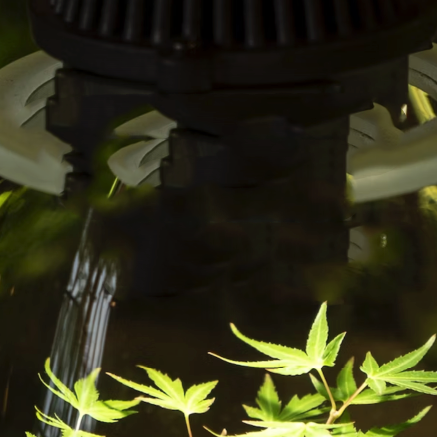The cost-of-living crisis is driving the price of energy, food and fuel through the roof and, like a lot of other people out there, many growers are getting left out of pocket. Grow room equipment can sometimes use quite a bit of power, so at a time when we're all trying to conserve a bit of energy, it's important to choose equipment that will give you the best value for money. The hydroponics industry has come a long way in recent years, with an array of new products that are much more efficient than their old-school counterparts, delivering better results while using less power. We'll talk you through a couple of items of equipment that's making growers more productive than ever in these difficult times.
Making the Switch from an RVK to a Revolution Vector
Here's an example of the kind of energy savings you can make when you switch from an AC fan to an EC fan of a comparable size and airflow rating.
RVK 6-Inch L - 109 watts @ 720 m3/hour
Vector EC 6-Inch - 76 watts @ 796 m3/hr
Knowing how many watts each fan consumes, we can run the numbers and work out the running costs. Let's start with the RVK, which consumes 109 watts and runs thorughout the day.
109 watts x 24 hours = 2616
Divide this number by a thousand to find the number of kilowatt hours per day.
2616 / 1000 = 2.62 kw/h
If we run the numbers in the same way for the Vector, we get the following results:
RVK 6-Inch L - 2.62 kilowatt hours (units) per day
Vector EC 6-Inch - 1.82 kilowatt hours (units) per day
At the time of writing, recent government updates have suggested that the current energy cap will sit at around 34 pence per unit. We can multiply the number of units by the cost of each unit to find our total running costs.
2.62 kw/h x 365 days x £0.34 = £325.14 per year
1.82 kw/h x 365 days x £0.34 = £225.86 per year
So we can see that switching to an EC fan is going to save £100 per year compared to an AC fan. But that's not even the full story - most growers run their fans using fan speed controllers, which increase or decrease output levels as needed, in order to maintain consistent climates. This means that you can run extraction systems well below their maximum output when temperatures are lower, during night-time periods and colder days, for instance. AC fans are highly inefficient in this regard - when turned down to lower output levels, they still use most (if not all) of their regular power draw. EC fans, on the other hand, are much more efficient: turn a Revolution Vector EC down to 5% and it will use around 5% of the power.
This means that you can reduce the power consumption of an EC fan EVEN FURTHER with a fan speed controller, lowering costs by an extra 25% to 50%. A silent running and highly effective digital fan speed controller can be purchased for just £82.45, in the form of the G.A.S EC1, and it's perfect for the job.
RVK 6-Inch L - £325.14 per year
Vector EC 6-Inch - £113 to £169 per year (when used with controller)
A Revolution Vector EC set-up can reduce running costs by around £200 per year, making it a real no-brainer of an investment, saving you huge sums of money (£1000 plus) over its lifespan. At the same time, you also get greater levels of airflow, as the Revolution produces an extra 76 m3/h of output per hour when compared to the RVK! Better performance, bigger savings! And this message rings true for the rest of the current crop of EC fans, like the Hyper Fan V2.
So What About Lighting, Your Main Energy Expense?
We'll give you the bad news first: most growers tend to swap out their old HPS lighting systems for LEDs that consume the exactly the same power - if they were running a 600w HPS, they generally make the switch to a 600w LED. In this instance, there's no saving to be made - 600 watts of power draw is going to affect your energy in the same way, no matter where it comes from. But here's the good news: 600 watts worth of next-gen LED is going to BLOW ITS HPS COUNTERPART OUT OF THE WATER in terms of performance.
600-watt HPS grow lamps can produce around 1.8 µmol for every watt of electricity they consume.
The Maxibright Daylight LED 660w Pro grow light, on the other hand, can hit a total efficiency of 2.7 µmol per watt.
This means that you can expect to get more useable light for every watt of electricity that's consumed, producing vastly superior results. The Maxibright LED uses the same power, and therefore generates the same energy costs, but it will produce much bigger yields, giving you a greater return on investment, even factoring in the greater initial outlay.
The efficiency of LEDs also ensures that less energy is lost as heat. This makes your environment easier to control, reducing fan speeds (saving you even more money) and improving plant health. The environment is one of the biggest factors in deciding the success of your crop. A healthy, optimal environment reduces stress, allowing plants to reach their full potential, making them as productive as possible. It's not uncommon for growers to see improvements in yield of 25% or more when making the switch.
Final Thoughts
Though times are getting tougher and energy costs are increasing, there's still plenty of profit to be made from indoor growing. When your grow is running more efficiently with next-gen equipment, your energy costs will plummet and the size of your harvest will massively outweigh your outgoings.

